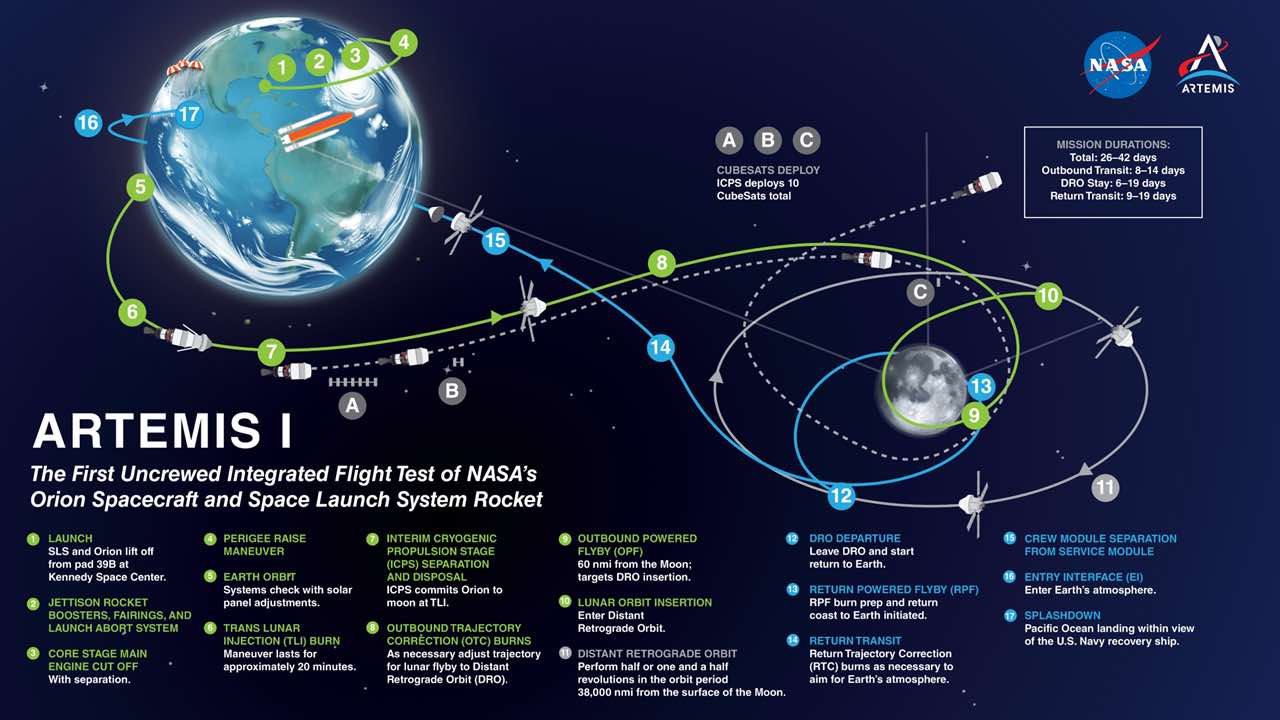
NASA’s Orion spacecraft fired its main engine Friday to slip into a distant lunar orbit, putting it on course to range farther from Earth than any of the Apollo astronauts flew in humanity’s first exploration missions to the moon.
The unpiloted capsule fired its space shuttle-era main engine for 88 seconds at 4:52 p.m. EST (2152 GMT) Friday. The hydrazine-fueled engine produced about 6,000 pounds of thrust to nudge the Orion spacecraft into a distant retrograde orbit around the moon in the third of five main engine burns of the Artemis 1 mission.
The distant retrograde orbit insertion burn, or DRI burn, Friday changed the spacecraft’s velocity by 247 mph (398 kilometers per hour) as Orion flew about 57,000 miles (92,000 kilometers) from the moon.
The previous major engine burn by the Orion spacecraft occurred Monday, Nov. 21, as the capsule flew just 80 miles (130 kilometers) above the lunar surface. The powered flyby maneuver leveraged the moon’s gravitational force to direct it toward the distant retrograde orbit, or DRO. In the DRO, the Orion spacecraft will have an average distance of about 43,000 miles (70,000 kilometers) from the moon.
The DRO has its name because it is not a low-altitude orbit like the Apollo capsules of the 1960s and 1970s flew in, and because Orion will move around the moon in the opposite direction the moon travels around Earth.
Mission planners chose the orbit for the Artemis 1 mission for several reasons. First, the Orion spacecraft’s propulsion system does not have the capability to steer the capsule into a low-altitude orbit around the moon as the Apollo missions did. And the DRO is stable because it is near the balance point between the pull of gravity from Earth and the moon, reducing the fuel Orion needs to burn to maintain its orbit once it arrives.
The Orion spacecraft will spend about six days in the distant retrograde orbit performing tests and checkouts, long enough to complete one-half of a lap around the moon. On Saturday, the capsule broke the distance record for a spacecraft designed to carry humans into space and return them to Earth, according to NASA.
The record was previously set on NASA’s Apollo 13 mission, which reached a distance of 248,655 miles (400,171 kilometers) from Earth when it looped around the far side of the moon with a three-man crew in 1970. Apollo 13’s moon landing was aborted when one of its oxygen tanks exploded on outbound journey from Earth, and the spacecraft steered onto a “free return” trajectory that took it farther from Earth than any of the other Apollo missions.

While there are no humans on-board Artemis 1, there are three instrumented mannequins inside the Orion spacecraft’s pressurized cabin to gather data on accelerations, vibrations, and radiation on the flight to the moon and back.
The Orion spacecraft will reach its greatest distance from Earth Monday, Nov. 28, at more than 268,500 miles (432,000 kilometers). On Thursday, Dec. 1, the capsule will fire its engine again to exit the distant retrograde orbit and swing back toward the moon for another low-altitude powered flyby Dec. 5 on the return leg to Earth.
Splashdown of the Orion capsule in the Pacific Ocean is scheduled for Dec. 11.
In the days preceding the distant retrograde orbit insertion burn, flight controllers at NASA’s Johnson Space Center in Houston performed more testing of the Orion spacecraft’s star trackers, cameras that are used to help the capsule determine its position and orientation in space. Engineers have been evaluating data from star trackers to determine how their images are affected by flashes from thruster firings, a phenomenon known as “dazzling.”
On Thursday, the Orion spacecraft fired its auxiliary engines for 17 seconds for an outbound trajectory correction maneuver. This small burn changed the spacecraft’s velocity by about 8.9 feet per second.
Other tests performed earlier in the week included a checkout of the Orion reaction control system engines to evaluate their performance in standard and non-standard thruster configurations.
The Artemis 1 mission lifted off from Kennedy Space Center on Nov. 16 aboard the first flight of NASA’s Space Launch System moon rocket, a super-heavy lift launcher designed to propel astronauts crews toward the moon.
Artemis 1 is a test flight before NASA commits to flying astronauts on the SLS moon rocket and Orion spacecraft. If the Artemis 1 mission concludes successfully, the space agency plans to fly three U.S. astronauts and a Canadian astronaut around the far side of the moon on the Artemis 2 mission as soon as late 2024. That will be followed by lunar landing missions later in the 2020s, and construction of a mini-space station in orbit around the moon.
Email the author.
Follow Stephen Clark on Twitter: @StephenClark1.
from Spaceflight Now https://ift.tt/wm7j6XP
via World Space Info







0 comments:
Post a Comment